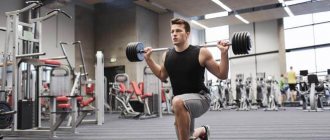A workout plan that will help you get rid of fat in problem areas and improve your body tone
Fact: This three-month workout plan, developed by New Jersey and New York-based certified trainers Jessica Cifelli and Greten Raddatz, probably won't appeal to anyone looking to lose weight quickly. Here you will not find strict diets and grueling workouts. Instead, you'll work toward your goal consistently and gradually, alternating cardio, strength, and toning exercises with periods of rest.
This is the only way you can achieve the desired shape and maintain the result for a long time. And, of course, don’t forget about nutrition. Be forewarned: you'll have to cook a few days ahead and eat healthy, because even the most intense workout won't bring you any closer to your goal without eating a balanced diet. Are you ready to start? Then we wish you good luck!
7-9 week
Getty/Svetikd
At this stage, more complex movements are added that require strength and balance to work the upper and lower body.
Monday: lower body
Warm-up:
Perform each dynamic exercise for 45 seconds, with a 15-second rest in between. Once you've finished your exercises and stretched, finish your warm-up with jumping rope. Try to do 3 sets of 100 jumps. Rest no more than 1 minute between sets.
1. Exit to plank from a standing position and back
2. Squats
3. Exit from a straight plank to a side plank while simultaneously raising your arms and legs
4. Pulling your knees to your chest while standing
Repeat the circle 2-3 times.
Training:
We recommend using medium weights when performing exercises to achieve greater results. Once you've completed all the circuits, finish your workout with five minutes of stretching.
1. Weighted Step-Ups: 24 reps
2. Squats with dumbbells on shoulders: 12 reps
3. Lateral lunges with dumbbells: 24 reps (12 on each leg)
4. Wide-legged squats: 30 seconds
Rest for 30-45 seconds and repeat the circuit 2-3 times
Tuesday: Cardio
Do a cardio or yoga workout for 1 hour. You can choose any of the workouts you already know below.
Option 1. Interval running on the track
Option 2. 60-minute cardio workout with boxing elements
Option 3: 30-minute power yoga
Option 4. Home yoga aimed at working out the abs
Benjamin Klaver/Unsplash
Wednesday: whole body
Perform each exercise in a circuit for 40 seconds. Pay attention to the rest time: on the 7th week, the rest between circles will be 1 minute, on the 8th – 45 seconds, on the 9th – 30 seconds. If necessary, use medium-weight weights. After you've completed all the circuits, finish your workout with five minutes of stretching.
1. Dumbbell rows to the chin
2. Reverse lunges + standing dumbbell shoulder press
3. Dumbbell plank with alternate arms back
4. Glute Bridge with Dumbbell Press
5. Lateral crunches from dumbbells to an extended leg
Rest as recommended above and repeat the circuit 5 times.
Thursday: interval cardio
Complete this 24-minute high-intensity treadmill workout. But first, warm up with a seven-minute run and joint exercises to warm up your muscles and prepare them for the load.
1. Running at a fast pace: 1 minute
2. Walking or light jogging: 1 minute
Repeat the circle 12 times.
Getty/Spyderskidoo
Friday: upper body
Warm-up:
Perform each dynamic circuit exercise for 30 seconds, taking a 10-second break in between. Once you're done, finish your warm-up with jumping rope. Do 3 sets of 100 jumps each, resting 1 minute in between.
1. Circular rotations with arms: 30 seconds forward and 30 seconds back
2. Plank with alternate arms raised to the sides
3. Jumping with arm rotation
4. Sumo squats with boxing with both hands at the bottom
Training:
Use heavy weights to perform these exercises. After you complete the circuits, finish your workout with a five-minute stretch.
1. Bent-over dumbbell arm extension: 15 reps per arm
2. Raise your arms forward and to the sides with dumbbells: 20 repetitions for each side
3. Bent-over dumbbell raise: 15 reps per arm
4. Bent-over dumbbell swings to the side: 15 reps
5. Hammer exercise: do 20 reps
6. Dumbbell Snatch + Press Up: 10 reps per arm
Repeat the circle 3 times. Rest between circuits for 1 minute in week 7, 45 seconds in week 8, and 30 seconds in week 9.
Training program for three months - basic exercises
Month 1
The complex consists of 5 manipulations, each of which must be repeated 10-12 times, moving from one to another with virtually no rest. Having completed one circle, take a minute break and repeat the approach. Only 3 approaches.
- Starting position: standing, feet shoulder-width apart, knees slightly bent, holding a weight or dumbbell in your hands. We begin to perform classic squats with a straight back and moving the pelvis back.
- We don’t change the position, we just lower our arms with dumbbells along the body, pressing them with our palms to our hips. The first step is to bend our elbows, bringing the weights into the chest, and the second step is to raise our arms up, squeezing the dumbbells to the maximum. At the highest point, objects should be above the shoulders.
- The starting position is the same. We lean forward, moving the pelvis back, arms with dumbbells hanging down, they should fall below the knees. We return to the starting position.
- We lie down on a bench, legs bent at the knees, feet on the floor. Hands with dumbbells are extended upward at shoulder level, you can bend your elbows slightly. We begin to lower the projectiles back, but without dropping them, but by controlling the movements. Having reached the maximum point, we return to the starting position.
- From a standing position, lean your body forward, slightly moving your pelvis back, legs together. The dumbbells we hold in our hands should be approximately at knee level. We pull one of the projectiles to the corresponding side of the abdomen, make a slight turn in the same direction, return to the starting position, change hands. At first, you can only use one dumbbell.
Month 2
There are only 4 exercises, each performed 15 times. The workout should not exceed 15 minutes, so the number of approaches depends on the speed of work. Pauses are permissible, but only if the technique begins to suffer from fatigue.
- We take dumbbells in our hands and stand in front of the step platform. We perform the most common arbitrary steps.
- We take a push-up position and start running in a horizontal plane. We pull our legs as high as possible and don’t slide our toes on the floor. We work rhythmically and quickly.
- We take dumbbells in our hands, bend our elbows and lift the weights to shoulder level, and sit down in a squat. Straightening your legs and back, raise your arms above your head, squeezing the dumbbells, returning to the starting position.
- We stand straight, feet shoulder-width apart, arms raised above our heads and holding a medicine ball (a special heavy ball). We sit down slightly, lean forward and forcefully throw the ball in front of us. Without resting, lift the apparatus and repeat the exercise.
Month 3
There are even fewer exercises - 3. We perform each exercise 15 times, after the circle we rest for 30 seconds and continue. A total of at least 4 laps.
- We perform classic lunges with dumbbells in our hands. At the end point, the legs should form right angles at the knee joints. After a week of training, you need to complicate the exercise by changing legs while jumping.
- We lie down on the floor, place our legs straight with our calves on the fitball. Lifting the pelvis from the floor and rolling the ball, we raise the lower part of the body, resting our feet on the projectile, the knee joints should form a right angle at the end point.
- We stand with our forearms on the fitball, stretch our body in a straight line, feet on toes. You need to stand in such a plank for at least a minute (you can start with small segments that form a minute). Just one rep!
10-12 weeks
Sarah Cervantes / Unsplash
Monday: lower body
Warm-up:
Perform each dynamic circuit exercise for 45 seconds, with a 15-second break in between.
1. Wide Leg Squats
2. Reverse lunges with body rotated to the side
3. Plank with alternate arms raised to the sides
4. Swing your legs to the sides while standing
Repeat the circle 2-3 times. Once you're done, finish your warm-up with high-knee jumping jacks, jumping jacks, and squats, performing each exercise for 40 seconds with 20 seconds of rest in between.
Training:
Use heavy weights to perform these exercises. After you complete your circuits, finish your workout with five minutes of stretching.
1. Single-leg deadlift with dumbbells: 10 reps on each leg
2. Sumo squats with dumbbells: 20 reps
3. Single-leg glute bridge with dumbbells: 20 reps on each leg
4. Walking Lunges: 20 reps per leg
Repeat the circle 5 times.
How many reps per set is best for muscle growth?
This is perhaps one of the most important points in organizing the training process. Get it right and you can get the body you want faster than you think. And if you make a mistake, you will stop halfway and get stuck on a training plateau. That's how important it is. Unfortunately, this is also one of the most controversial issues. There are many theories and opinions, but most still point in one direction: If we want maximum muscle growth, then we should train with heavy weights and moderate volume. Thus, we need heavy weights (80% of one-time maximum) and a moderate number of repetitions per large muscle group per week. Here, as an example, are the results of one of the published studies, during which the subjects were divided into 2 groups: Group 1 - trained 4 times a week with weights of 70% of the one-time maximum. Performed 4 approaches for each exercise of 10-12 repetitions. Group 2 - trained 4 times a week with weights of 90% of the one-time maximum. Performed 4 approaches for each exercise of 10-12 repetitions.
Both groups did the same exercises (including bench press, barbell squats, seated military press, deadlift) and followed their usual diet, which was monitored by keeping diaries. And the result? After 8 weeks of training, the scientists concluded that the subjects in Group 2 gained significantly more strength and muscle mass than the participants in Group 1. It's not surprising that participants in the heavier lifting group gained strength, but many didn't expect any gains in muscle mass either. Researchers have formulated 2 reasons why heavy training is superior to lighter training:
1. Large mechanical load on the muscles. More repetitions, in turn, puts more stress on the metabolism. 2. Greater activation of muscle fibers. And this, in turn, leads to the involvement of a larger percentage of muscle tissue in the process. So what can we learn from all this? 1.Focus on heavier weights with fewer reps. This is more important than maximizing cellular fatigue with drop sets, giant sets, etc. 2. Concentrate on progressing the load. The key point is the emphasis on increasing the weight of the barbell, and not the number of repetitions in the approach. 3. The main emphasis is on multi-joint basic exercises . This does not mean that you need to exclude high-repetition pump training and isolation exercises from strength training. They're just not the main focus. How often should you train for maximum muscle growth? Many people believe that frequency of exercise is key.
For them, everything is black and white: if you don’t work the main muscle groups 2-3 times a week, you can forget about serious results. Sounds good for a motivational quote on YouTube, but misses the point. How often you can and should train directly depends on the intensity and volume of each individual workout.











